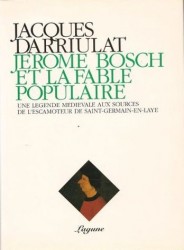
Darriulat 1995
Jérôme Bosch et la Fable Populaire – Une légende médiévale aux sources de L’Escamoteur de Saint-Germain-en-Laye (Jacques Darriulat) 1995
[Éditions de la Lagune, Paris, 1995, 160 pages]
This monograph, largely ignored by Bosch authors writing after 1995 (for obvious reasons, see below), focuses on the iconography of The Juggler, a sixteenth-century painting (more precisely a genre scene) by a follower of Bosch, today in the Musée Municipal of St-Germain-en-Laye (France) and perhaps a copy of a Bosch original. The book has two large sections.
The first section is fascinating and informative. Its subject is the legend, totally forgotten today but very popular and well-known in the Middle Ages, about the Roman emperor Nero who is told to have commanded his doctors – out of sheer curiosity – to let him become pregnant, so that he could experience what women feel when they give birth. The doctors, whose life was in danger, make the emperor swallow a potion through which in his stomach a frog (a toad or a worm according to other sources) grows and his belly swells up. Later, thanks to another potion, the frog (toad, worm) is thrown up again by the emperor. Darriulat offers an excellent overview of a large number of medieval texts in which this story is told [pp. 29-41]. Unfortunately, when he begins to look for the sources and the origin of the legend [pp. 41-62], his argument turns out far more speculative, as well as confused and confusing. Darriulat is convinced that Bosch knew this popular and folkloristic legend, because his art breathes a similar folkloristic spirit. Nevertheless, when he argues (on page 40) that Bosch did not paint for ecclesiastical or noble commissioners but for the citizens of ’s-Hertogenbosch (une clientèle composée ni d’ecclésiastiques ni de nobles, mais des bourgeois de Bois-le-Duc), he is obviously stretching the truth.
This is even more the case in the second section [pp. 65-125], which is completely dedicated to an iconographic interpretation of the Juggler panel. In the Conclusion [p. 125], Darriulat defends his interpretations by correctly pointing out that the medieval spirit, in particular when it comes down to symbolism and imagery, is pre-Cartesian, not based on logical reasoning but on associative thinking. It is true that when medieval authors present allegorical interpretations, in most cases it is not a matter of aut… aut… (either… or…, one possibility excluding the other) but of vel… vel… (or… or…, giving a number of possibilities of equal value). But when dealing with paintings by Bosch and his followers, does this offer a permit to write-whatever-you-like?
Because one of the figures in the Juggler panel (the stooping man who is part of the audience watching a juggler’s public performance and who is being robbed by the juggler’s assistent) is vomiting a frog, Darriulat wants to see a connection with the legend about Nero. In this, he goes very far. The stooping figure and the juggler are respectively and successively interpreted as Nero who is being fooled by Simon the Magician, as King Solomon and Marcolf, and as the pope who is led astray by bad counsellors. According to Darriulat, the complete scene is not only an example of the ‘topsy-turvy world’, but also sends out a warning of the dangers of hereticism. Moreover, the juggler himself is seen as the Antichrist, whereas in the Middle Ages it was Nero who was considered (the forerunner of) the Antichrist – as is nicely pointed out by Darriulat himself on the again noteworthy pages 112-114. In this second section, Darriulat’s argument is highly associative, jumping from here to yonder and back again, often partial to Hineininterpretierungen, and eventually not in the least convincing or plausible. What is being done here with a quite simple and understandable genre scene focusing on folly and fraud, can only be called ‘fooling around with Bosch’ (gesol met Jeroen Bosch, a phrase coined by father Gerlach in 1967). It is very cynical therefore that Darriulat writes in the beginning of his Conclusion [p. 121]: ‘La passion du décryptage aveugle les interprètes’ (the urge to decipher blinds the interpreters).
[explicit 16 April 2023]